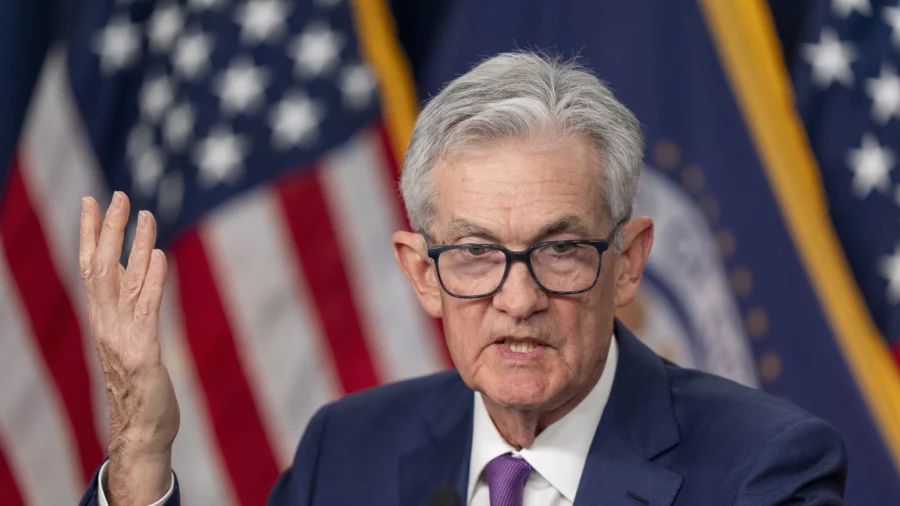Federal Reserve Chair Jerome Powell dashed the hopes of investors again, repeating the central bank’s position that it will not be as quick to cut interest rates as the financial markets anticipate.
During a lengthy interview with CBS News’ “60 Minutes” that aired on Feb. 4, Mr. Powell pledged to take a careful approach to reducing rates, arguing that policymakers want to observe “more evidence that inflation is moving sustainably down to 2 percent.”
Officials are growing confident that this is the case, alluding to six months’ worth of inflation figures, but they want more data “before we take that very important step of beginning to cut interest rates.”
“We want to see more good data. It’s not that the data aren’t good enough. It’s that there’s really six months of data. We just want to see more good data along those lines. It doesn’t need to be better than what we’ve seen, or even as good. It just needs to be good,” the Fed chief told host Scott Pelley.
Asked when the first rate cut could happen, Mr. Powell stated that it would depend on the data.
“The best we can do is to weigh the risk of moving too soon against the risk of moving too late and make that judgment in real time,” he said.
Monetary authorities would be quick to reduce rates if there was weakness in the labor market or inflation tumbled. But they might be reluctant to pivot because it would risk resuscitating inflation or stalling progress.
Ultimately, he noted that it is about balancing risks, including a recession.
“We have to balance the risk of moving too soon … or too late. And there are different risks. We think the economy’s in a good place. We think inflation is coming down. We just want to gain a little more confidence that it’s coming down in a sustainable way toward our 2 percent goal,” he stated.
At the January Federal Open Market Committee (FOMC) policy meeting, the central bank kept interest rates unchanged at a range of 5.25–5.5 percent. But it was what the FOMC statement said that caught the attention of investors.
“In considering any adjustments to the target range for the federal funds rate, the Committee will carefully assess incoming data, the evolving outlook, and the balance of risks,” the FOMC statement said. “The Committee does not expect it will be appropriate to reduce the target range until it has gained greater confidence that inflation is moving sustainably toward 2 percent.”
In addition, at the post-FOMC meeting press conference, Mr. Powell revealed that it was unlikely there would be rate cuts at the March meeting.
“I don’t think it’s likely that the committee will reach a level of confidence by the time of the March meeting” to cut rates, he said.
To kick off the trading week, U.S. stocks reacted and plunged on the Fed chair’s remarks, with the Dow Jones Industrial Average sliding about 400 points. The Nasdaq Composite Index and the S&P 500 Index tumbled as much as 1 percent.
According to the CME FedWatch Tool, the futures market is now pricing in a rate cut in May.
Prices
Over the last few years, cumulative inflation has run north of 18 percent. Prices for a wide range of goods and services have increased exponentially.
Asked if consumers can see prices coming down, Mr. Powell conceded that it would be a mix.
“The prices of some things will decline. Others will go up. But we don’t expect to see a decline in the overall price level,” he admitted. “That doesn’t tend to happen in economies, except in very negative circumstances. What you will see, though, is inflation coming down.”

Because prices for basic necessities, like bread, eggs, and milk, are substantially higher today than they were before the pandemic, the public “has been relatively dissatisfied with what its otherwise a pretty good economy.”
Outside of a sharp economic downturn, prices will not soften, except for goods that are affected by commodity prices, such as gasoline.
“But the overall price level doesn’t come down. It will fluctuate,” he added. “And some goods will, goods and services will go up, others will go down. But overall, in aggregate, the price level doesn’t tend to go down except in fairly extreme circumstances.”
Treasury Secretary Janet Yellen made a similar argument, telling ABC News that prices “are not likely to fall.”
“I think most Americans know that prices are not likely to fall,” she said last month. “It’s not the Fed’s objective to try to push prices back to where they were.”
Election 2024
The Fed has become the target of former President Donald Trump, while President Joe Biden has been relatively quiet on the central bank’s policymaking efforts.
Mr. Powell reiterated that the Federal Reserve is an independent institution and that it will not acquiesce to political pressure during an election year.
“We do not consider politics in our decisions. We never do. And we never will,” he said.
President Trump slammed the Fed’s leadership, accusing Mr. Powell of being “political.”
“I think he’s going to do something to probably help the Democrats, I think, if he lowers interest rates,” the Republican frontrunner said to host Maria Bartiromo.
While he did not say who he would appoint if he is elected in November, former President Trump revealed that he has “a couple of choices.”
From The Epoch Times

